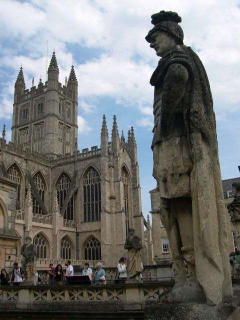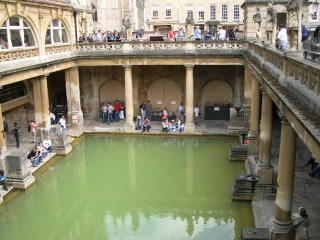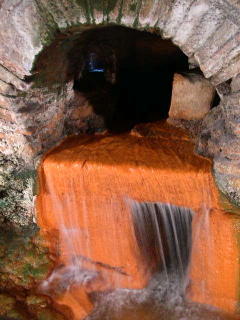city of Bath
 Roman Soldier, overlooking the Roman Bath.>.>
Roman Soldier, overlooking the Roman Bath.>.>@ Bath, Somerset, SW England.
The most interestin place in UK I've bn to yet.
During the Georgian era (17-18th century), it was a resort city of the wealthy filthy-rich.Interestingly, the railway station is still called Bath Spa.The look n feel of the place is quite different from other english-towns, which is the first thing that hits u when u step out of 'Bath Spa' station.. they say cos of the Georgian architecture.
[Following is not a trip journal, but the interesting information gathered during the trip, about an impressive aspect of Roman lifestyle, is collated and reproduced from existing websites mentioned in Ref section at the end ; Photos are from my trip album]
 The city of Roman Bath and temple of Aquae Sulis, was built around Britain's only hot-spring, which was considered sacred by the Romans and the native Celts before the Romans arrived in 43AD. Since Hot Spring phenomenon was beyond human understanding, it was believed to be the work of the Gods.
The city of Roman Bath and temple of Aquae Sulis, was built around Britain's only hot-spring, which was considered sacred by the Romans and the native Celts before the Romans arrived in 43AD. Since Hot Spring phenomenon was beyond human understanding, it was believed to be the work of the Gods.<.<.Statue of Goddess Minerva, excavated from the Temple site .
First frequented by Neolithic hunter-gatherer tribes, the springs were later venerated as sacred by Celtic, Roman, and Christian peoples. The Celts, who arrived in England around 700 BC, erected what are believed to be the first shrine structures at the springs. Dedicated to Sulis, a goddess of water, the shrine was a religious center for much of southwestern England. Soon after the arrival of the Romans in England in 43 AD, the Celtic shrine was taken over and the goddess Sulis was identified with the Roman goddess Minerva as a healing deity. Beginning sometime around 65 AD, and continuing for nearly four centuries, the Romans constructed increasingly elaborate bathing and temple complexes at the sacred springs.
Many objects were thrown into the Sacred Spring as votive offerings to the goddess, like thousands of Roman coins. Other special objects like curses with messages inscribed on sheets of lead or pewter, which were then rolled up and thrown into the Spring where the spirit of the goddess dwelt. Special metal pans, known as paterae, might have been used for making offerings of holy water. They are inscribed with the letters DSM or the words Deae Sulis Minerva which shows that they were dedicated to the goddess Sulis Minerva.
 <.< where Romans bathed
<.< where Romans bathedHere's more about Roman baths in general, across Roman Empire :
http://www.cyberbohemia.com/
Pages/massbathing.htm .>.> Before Emperor Agrippa designed and created the first thermae in 25 BC, the smaller, more frequent balneum had been enjoyed by Roman citizens for more than 200 years.
The thermae, from the Greek word for "heat," became the pet project for all Roman emperors following Agrippa. Each tried to out-do his predecessor, making his bath more spacious, more splendid, more popular. To insure their popularity, entrance fees were ridiculously low, if not free. Without generating enough revenue to maintain themselves, the thermae had to be subsidized. Emperors, of course, enjoyed their own baths, and some were said to have bathed seven or eight times a day.
Like the balneum, the thermae sprung up everywhere in the Roman empire, from sandy African deserts to the snowy Alps, and as far north as England.
The concept of a thermae was an all-encompassing recreational center.Most thermae walls enclosed sports centers, swimming pools, parks, libraries, little theatres for poetry readings and music, and great halls for parties.. [++contd..]

Hot Spring overflow: Surplus water not used in the baths flows out to the Roman Drain. Water at ~46deg C rises at the rate of~1.2million Litres everyday from the spring. The sulphur and minerals in the water stains the stones yellowish orange>.>
[++contd..] At the center, of course, the main attraction was always the baths themselves--hot water baths, cold water baths, hot-air baths, virtually every type of bath that ingenuity and lust for bathing could devise.
A typical routine might begin with a strenuous workout in the palestra, or courtyard, where various sports and activities loosened up the body and stimulated circulation.
Afterwards, the bather would trek through three rooms, progressing from tepid to hot. The first room was known, appropriately enough, as the tepidarium, the largest and most luxurious in the thermae. Here, the bather relaxed for an hour or so while being annointed with oils. Then he moved into the little bathing stalls of the caldarium, much like the halvet in Islamic hammams, providing a choice of hot or cold water for private bathing.
The final and hottest chamber was the laconicum. (The English word "laconic" comes from the regimented province of Laconica where people were characterized as brief, concise and terse.) After an understandably laconic stay in the laconicum, the body was primed for a vigorous massage, followed by a scraping off of dead skin with the strigil. A thorough scrubbing and a cool dip in the pool of the frigidarium was next. Refreshed and smelling like a rose, the bather then retired to the outer areas of the thermae where a library or an assembly room were among several attractions that encouraged intellectual pursuits.
Roman engineers devised the hypocaust (under-floor heating) method to heat bath air to temperatures exceeding l00 degrees C.--so hot that bathers had to wear special shoes to protect their feet from the blistering floor. They accomplished this by heating the marble floor, raised on pillars of stacked tiles. Hot air was supplied from the furnace and the hypocaust system carried the heat around the complex. Central heating worked because hot air moved thro
 ugh spaces under the floors and up the walls, channeled through earthenware pipes in the walls. It took two or three days to heat a thermae, but that mattered little, as the baths were kept perpetually hot.
ugh spaces under the floors and up the walls, channeled through earthenware pipes in the walls. It took two or three days to heat a thermae, but that mattered little, as the baths were kept perpetually hot.It was the slaves' job to keep the furnace well stoked up so that the central heating worked.
Remains of the Roman Hypocaust heating: >.>
(Furnace hole and the pilae- pillars of tiles which
supported the floor are seen.)
http://www.bbc.co.uk/schools/romans/tech.shtml -- The Romans were good at building and engineering, but not so good at inventing machines. There were always plenty of slaves to do the nasty jobs, so nobody bothered to think up machines that could take their place. An example of this was central heating which involved lots of effort from Roman slaves. Public baths and rich people's houses all had central heating.
Ref: - http://www.cyberbohemia.com/Pages/massbathing.htm
-- http://www.vroma.org/~bmcmanus/baths.html
-- http://www.historylearningsite.co.uk/roman_baths.htm
-- http://www.romanbaths.co.uk/
Roman Invasion of Britain -- http://www.smr.herefordshire.gov.uk/roman/invasion.htm


0 Comments:
Post a Comment
<< Home